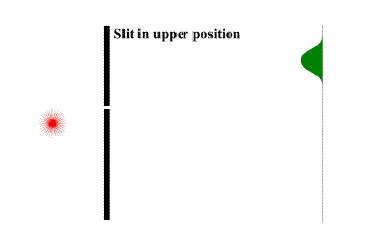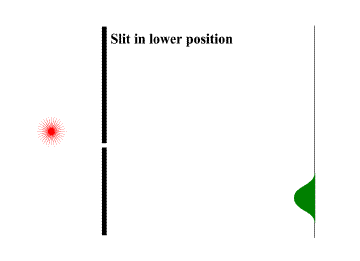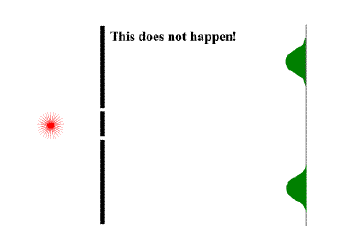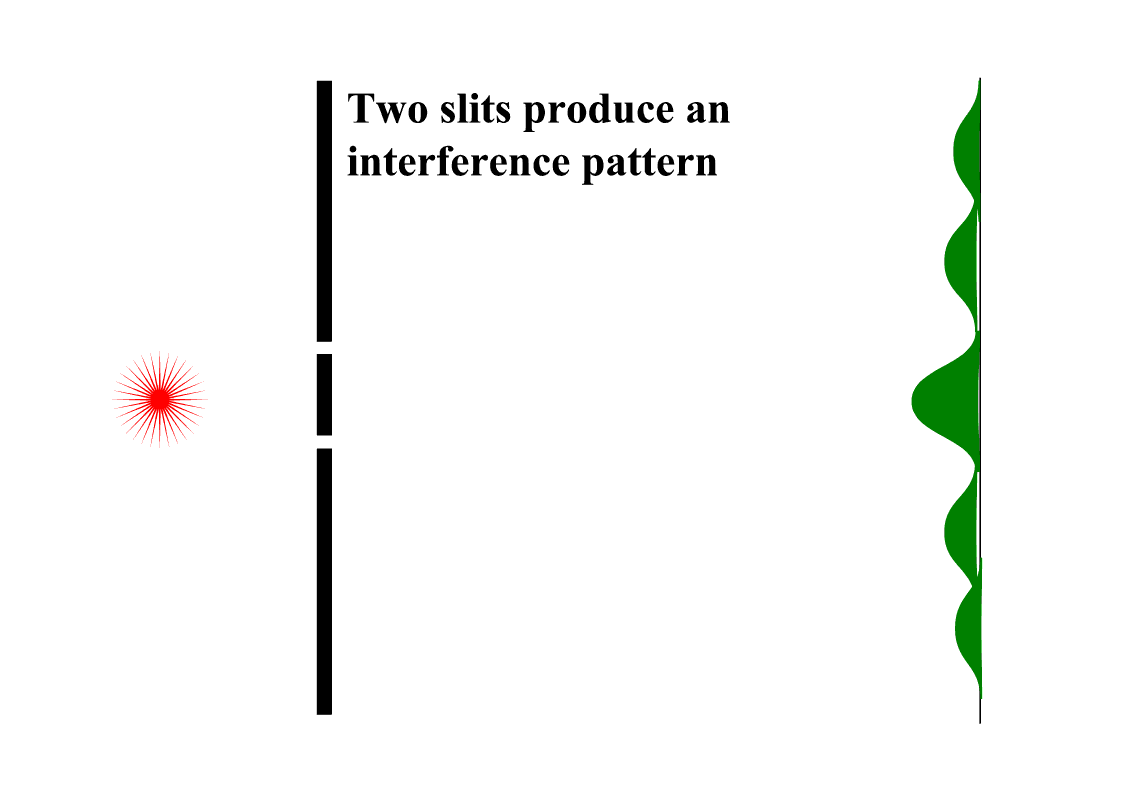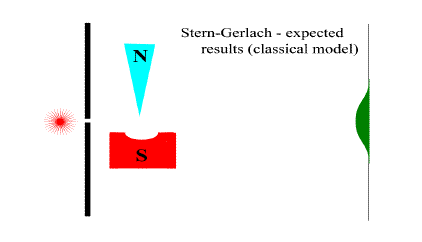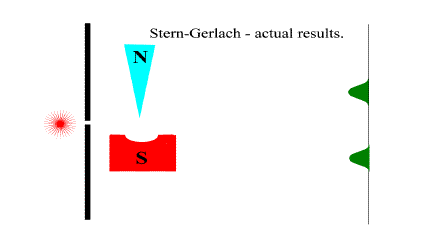| We are therefore left with three possible conclusions:
(1) The apparatus somehow forces the particles to align parallel to its magnetic field
before it deflects them.
OR
(2) The particles are not emitted with random orientation but are produced either up or
down.
OR
(3) The particles have no orientation until it is observed. The act of observation
produces the orientation.
Alternative one - forced alignment - can be rejected because there is no known two-step
mechanism whereby a magnetic field would wait until it had aligned all the miniature
magnets before it decided to turn on the deflection. Also, progressively weakening and
shortening the magnetic field would be expected to allow some particles to escape the
alignment process. But this does not happen. Particles are, within the limits of
experimental measurement, all deflected to exactly the same extent either up or down.
Alternative two - non random orientation - can be disproved by observing what happens when
the incoming beam is left unchanged and the the Stern-Gerlach magnet is rotated through 90
degrees. The particles are then either deflected left or right with nothing in between. In
fact the orientation is totally arbitrary. If the Stern Gerlach magnets are aligned at
orientations corresponding to any axis (one o'clock/seven o'clock or two o'clock/eight
o'clock) etc then the original beam will split into two beams with all
particles showing an equal deflection towards the one'clock or seven o'clock position.
So we are left with alternative three - the orientation has no inherent existence. The
attribute of orientation is utterly meaningless in the absence of an observer. The meaning
of the orientation is projected by the observer's mind. If the observer projects the
up/down axis of orientation on a stream of particles then that is the way that they will
all be sorted. If any other direction is chosen then they will be sorted along that axis.
Quantum theory does not appear to allow any fundamental distinction between the mind of
the observer and what is being observed. Full details of the Stern-Gerlach experiments are
given in Where Does the Weirdness Go? by David Lindley [LINDLEY 1997b]
Spooky action at a distance -
EPR
One of the most vivid illustrations of the interactions of the mind of the observer with a
quantum system is given by EPR - the 'Einstein Podolsky Rosen Paradox', or 'Spooky action
at a distance' as it is sometimes known. The experimental evidence seems to show that the
observer's mind goes to its object unobstructedly and instantaneously, for example through
ten kilometres of intervening Geneva city-scape (walls, buildings, railway stations, the
lot!) at speeds exceeding that of light.
Nor does the effect diminish with distance. According to the Copenhagen interpretation of
quantum theory, the 'spooky action' can affect a particle instantaneously whether it is a
metre away from the observer or halfway across the universe.
The observation of 'spooky action' relies on the concept of entanglement. It is possible
to obtain pairs of fundamental particles where it is known that their properties will
always cancel one another out, even when those properties have not been defined. These
pairs are said to be 'entangled' . However the entanglement is conceptual rather than
physical and the particles are free to move far apart.
Consider an experiment where we create an entangled pair of magnetic particles. Their
polar alignments will always be opposite. We allow them to move far apart. We then place a
Stern-Gerlach magnet in the path of one of the particles and observe what happens when it
passes through. If it is defected upwards then, according to the 'spooky action'
hypothesis, its distant partner would be deflected downwards by a similar magnet. By
making the nearby observation we have instantaneously defined the properties of the
distant particle.
Note that this is not the same thing as saying 'The near particle was always up but we
didn't know until we decided to observe it. So the distant particle must always have been
down even though we didn't know at the the time.'
The reason the statement above is incompatible with quantum theory is that we could have
equally well decided to align the Stern-Gerlach magnet on a left/right axis instead of
up/down. In which case we would have fixed the near particle as, say, left-deflected and
the distant particle would instantaneously be known to be right-deflected.
For many years both theoretical and technical difficulties stood in the way of determining
whether 'spooky action' does indeed take place. However as a result of the theoretical
work of John Bell and the ingenious experimental designs of Alain Aspect strong evidence
was obtained that the effect occurred over distances of a few metres. The act of making a
decision of what attributes of one member of an entangled pair were to be observed
immediately determined what could be observed of the other member.
Since then 'spooky action' has been demonstrated over increasing distances. The current
record is 10 km obtained by Nicolas Gisin and his team at the University of Geneva
[BUCHANAN 1997]. Starting from near Geneva railway station they sent entangled photons
along optical fibres through the city to destinations separated by 10km. They showed that
observing the state of one member of the pair instantaneously determined the state of the
other.
Quantum sunyata
Basically, what quantum theory says is that fundamental particles are empty of inherent
existence and exist in an undefined state of potentialities. They have no inherent
existence from their own side and do
not become 'real' until a mind interacts with them and gives them meaning. Whenever
and wherever there is no mind there is no meaning and no reality. This is a similar
conclusion to the Mahayana Buddhist teachings on sunyata.
The ultimate manifestation of quantum sunyata is when quantum theory is
applied to the entire universe. According to some cosmologists, the universe began as a
quantum fluctuation in the limitless Void (Hartle-Hawking hypothesis). The universe
remained as a huge quantum superposition of all possible states until the first primordial
mind observed it, causing it to collapse into one actuality. This fascinating theory is
discussed in The Participatory Anthropic Principle.
- Sean Robsville
See also:
Rational
Buddhism
Buddhism,
Quantum Physics and Mind
REFS
[LINDLEY 1997a] Lindley, David, Where does the Weirdness Go? page 39ff. (London: Vintage
1997, ISBN 0 09 974751 0 )
[LINDLEY 1997b] ibid, page 8 ff.
[BUCHANAN 1997] Buchanan, Mark , Light's Spooky Connections Set Distance Record , New
Scientist, 28 June 1997, p 16.
[PENROSE 1990a] Penrose, Roger, The Emperor's New Mind, page 385 (London: Vintage, 1990,
ISBN 0 09 977170 5)
[PENROSE 1990b] ibid page 299f
Christian
versus Buddhist worldviews |
